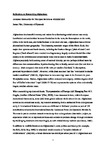Reflections on Researching Afghanistan
| dc.contributor.author | Flint, J | |
| dc.date.accessioned | 2019-08-27T14:01:32Z | |
| dc.identifier.uri | http://hdl.handle.net/10026.1/14819 | |
| dc.description.abstract |
Afghanistan is a beautiful country and makes for a fascinating social science case study. Landlocked and sandwiched between Persia/Iran in the west, the Russosphere to the north, China in the north-east, and India/Pakistan to the south and east, Afghanistan has a diverse physical and human geography. The dissecting mountain ranges of the Hindu Kush, four major river systems and harsh deserts, including the Dasht-e-Margo (‘plain of death’) and Registan (‘land of sand’) have resulted in a fragmentary, largely rural and feudal-like tribal society in the provinces and a historically weak central state in Kabul’s mountain basin. Afghans popularly hold a strong sense of national identity, yet one perhaps defined more by differences than commonalities, loyalties leaning first to family, second unto God and third to country. Shah compared this mode of life with pre-modern Scotland, “a clan system, governed by predatory chiefs”. However, while Shah assumed that this “eventuated in similar modern conditions” (1982:9), Afghanistan is not a sovereign state in the Eurocentric, postWestphalian sense. Rather, Afghanistan suffers contested sovereignty, exhibits degrees of all four of Collier’s theorised ‘traps’ (2008:17-78) and represents the epitome of an endemically fragile, conflict-affected state. | |
| dc.language.iso | en | |
| dc.title | Reflections on Researching Afghanistan | |
| dc.type | journal-article | |
| plymouth.volume | 5 | |
| plymouth.publisher-url | http://www.theopenreview.com/volume-5-2019/ | |
| plymouth.journal | The Open Review | |
| plymouth.organisational-group | /Plymouth | |
| plymouth.organisational-group | /Plymouth/Faculty of Arts, Humanities and Business | |
| dcterms.dateAccepted | 2019-08-06 | |
| dc.rights.embargodate | 2020-5-29 | |
| dc.rights.embargoperiod | Not known | |
| rioxxterms.licenseref.uri | http://www.rioxx.net/licenses/all-rights-reserved | |
| rioxxterms.type | Journal Article/Review |


